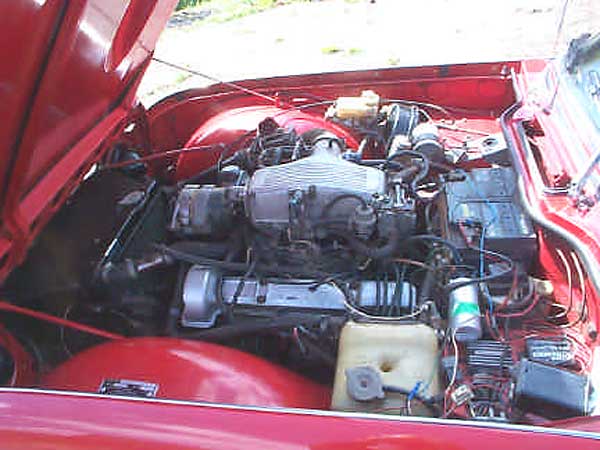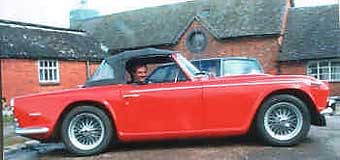
Neil Brown's 1968 TR-250 with a Triumph Stag V8 Engine
as published in British V8 Newsletter, Volume X Issue 3, September 2002Owner: Neil Brown
City: Staffordshire, England
Model: 1968 Triumph TR250
Engine: Triumph Stag V8
Conversion completed by: Owner
I don't think you can beat the sound or the torque of a V8. The "burble" is fantastic & is enough to turn most heads even when the car is being driven modestly. Mine really gets people's attention at speed! The torque from a V8 also makes driving a pleasure & consequently I wanted to get a V8 into my Triumph TR250. However, I farm in Staffordshire England and do not have much surplus time. Consequently, my objective was to find the quickest transplant I could. Like most enthusiasts, at least in the UK, I first started measuring up an ex Buick 3500/4000cc Rover engine. However, it quickly became obvious that the gearbox might take some time to fit as might the exhaust headers. Working forward from the gearbox, which I decided to retain if possible, a Triumph Stag engine looked overall an easier fit than the Rover.
My original TR gearbox was, of course, very little different from the Stag's transmission. There is a slight complication in that the Stag tranny sits at the back of the Stag's engine on a slight angle. Consequently the gear lever tends to twist to one side & requires a compensatory sideways shift. I cut the gearlever off just above the ball, welded a plate to the now foreshortened top & then re-weld the gear stick to the plate.
There isn't a lot of room between the cylinder heads of any V8 & the inner-wings. However, as I got into more detail I realized that the Stag engine was actually easier to fit than the Rover since the Stag's cylinder heads have angled (downwards) exhaust header flanges - which would make it far easier to take the headers away close to the block. The Rover's cylinder heads have vertical faces to the exhaust flanges necessitating the pipes loop away from the heads. The final clincher was that I thought that I would have the barest minimum of bulkhead changes to make, if any at all.
So the Stag appeared to be the easier engine to squeeze in & the 180cu in iron
block / aluminum heads would be about the same weight as an original Triumph - so I
decided to give it a go. Nevertheless I had to bias the engine towards the left side
of the car (by about 1") to give the steering column a little room & still managed
to get the left-side exhaust header down the side of block with hardly any carving -
certainly none worth talking about. Moving the engine an inch to the left was not in
fact the whole story, for the steering rack had to be moved an inch to the right too!
I made a lower steering column complete with the extra u-joint.
The Stag engine is actually shorter (about 1") than the original 6-cylinder unit so I thought the engine should sit clear of the car's bulkhead. Indeed it does! So what about the comparative heights? Stag wins again, but not by much. It is about 1" lower than the Rover V8, which allowed me to close the bonnet/hood without any difficulty even with the efi induction in place.
Anyone interested in Triumph cars has to have heard that the Stag engine's reliability is questionable. Back in the 1970's the car sadly developed an entirely deserved reputation for overheating, warped cylinder heads & some doubt as to what car you would come home in when you left in a Stag! We have some very experienced Stag specialists in the UK & I visited a number at a Triumph show / meet & was told the basics as to what I must do to make my unit reliable. I learnt it is very important to change the engine oil & filter regularly every 3000 miles to give the timing chains longevity. You will also need to change the timing chains about every 30000 miles. Sooner if they get noisy earlier than that, which also tells you that you are not changing the engine oil sufficiently frequently.
To help my water pump stay submerged I fitted an enlarged header tank & fitted an automatic air-bleed from the top of the radiator to the additional header tank on the advice of the Stag experts.
Strangely enough, finding a place for and mounting the alternator was my biggest challenge.
Since I had managed to retain the original gearbox, the original prop-shaft, rear suspension & drive shafts were hardly changed at all. I fitted hard polyurethane pivot bushes to the trailing arms & have had no problems there in spite of using the car every day, rain, shine or snow. However, the extra torque from the V8 is showing-up the numerous universal joints in my drive train as now being inadequate & upgraded u-joints are going to be required soon.
I swapped the car's original 3.7 ratio rear axle for the slightly "taller" 3.45 one - which has worked out really well.
My initial induction was a Holley 390cfm 4-barrel carburetor, but its flat-spots brought me to change to an ex-Rover EFI system. I am delighted with this upgrade & feel it has "made" the car with its balance of good manners & power - depending upon my right foot!
The Stag engine is actually shorter (about 1") than the original 6-cylinder unit so I thought the engine should sit clear of the car's bulkhead. Indeed it does! So what about the comparative heights? Stag wins again, but not by much. It is about 1" lower than the Rover V8, which allowed me to close the bonnet/hood without any difficulty even with the efi induction in place.
Anyone interested in Triumph cars has to have heard that the Stag engine's reliability is questionable. Back in the 1970's the car sadly developed an entirely deserved reputation for overheating, warped cylinder heads & some doubt as to what car you would come home in when you left in a Stag! We have some very experienced Stag specialists in the UK & I visited a number at a Triumph show / meet & was told the basics as to what I must do to make my unit reliable. I learnt it is very important to change the engine oil & filter regularly every 3000 miles to give the timing chains longevity. You will also need to change the timing chains about every 30000 miles. Sooner if they get noisy earlier than that, which also tells you that you are not changing the engine oil sufficiently frequently.
To help my water pump stay submerged I fitted an enlarged header tank & fitted an automatic air-bleed from the top of the radiator to the additional header tank on the advice of the Stag experts.
Strangely enough, finding a place for and mounting the alternator was my biggest challenge.
Since I had managed to retain the original gearbox, the original prop-shaft, rear suspension & drive shafts were hardly changed at all. I fitted hard polyurethane pivot bushes to the trailing arms & have had no problems there in spite of using the car every day, rain, shine or snow. However, the extra torque from the V8 is showing-up the numerous universal joints in my drive train as now being inadequate & upgraded u-joints are going to be required soon.
I swapped the car's original 3.7 ratio rear axle for the slightly "taller" 3.45 one - which has worked out really well.
My initial induction was a Holley 390cfm 4-barrel carburetor, but its flat-spots brought me to change to an ex-Rover EFI system. I am delighted with this upgrade & feel it has "made" the car with its balance of good manners & power - depending upon my right foot!


